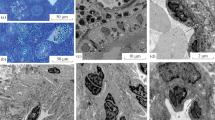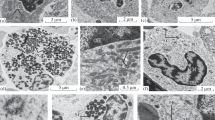Abstract—
The mesonephros ultrastructure has been studied for 12 specimens of sexually mature Carassius gibelio Bloch 1782 living in the freshwater Finogenov Pond and in the middle reaches of the Khara River (salinity of 6‰). Both reservoirs belong to the basin of the Volga River. A slight increase in the water salinity up to 6‰ primarily caused changes in the quantitative characteristics of leukocyte mitochondria and in all types of epithelial cells, as well as specialized types of inclusions in eosinophils, macrophages, proximal tubules type I, and distal tubules of the nephron. There were also changes in the nuclear structures of some types of interstitial cells and epitheliocytes. In the nephron tubules, epithelial cells of smaller sizes were registered, in the epithelial cells of the tubules, there was a more developed smooth endoplasmic reticulum, as well as a shorter brush border of the proximal tubule cells. As the water salinity increased, the area of the renal corpuscles, of glomerular capillaries, and of podocytes decreased, the thickness of the basement membrane and mass transfer in the renal corpuscles and tubules changed as well. Cytological rearrangements during the transition of the stenohaline freshwater species to brackish water testified to the high adaptive capacity of the cellular structures of the mesonephros.





Similar content being viewed by others
REFERENCES
Birrer, S.C., Reusch, T.B., and Roth, O., Salinity change impairs pipefish immune defence, Fish Shellfish Immunol., 2012, no. 33 (6), pp. 1238–1248.
Bryan, R., Cullen nuclear RNA export pathways, Mol. Cell. Biol., 2000, pp. 4181–4187.
Burkova, T.N., Characteristics of phytoplankton of the highly mineralized Khara River, Izv. PGPU im. V.G. Belinskogo, 2011, no. 25, pp. 493–496.
Elger, M. and Hentschel, H., The glomerulus of a stenohaline fresh-water teleost, Carassius auratus gibelio, adapted to saline water. a scanning and transmission electron-microscopic study, Cell Tissue Res., 1981, no. 220 (1), pp. 73–85.
Eshonov, Kh.K.O., Structural and functional organization of nuclear pores, Materialy III Nauch.-prakt. konferentsii. Novoe v biologii i meditsine (Proc. III Sci. Pract. Conf. “New in Biology and Medicine”), 2018, pp. 85–92.
Flerova, E.A., Kletochnaya organizatsiya pochek kostistykh ryb (na primere otryadov Cypriniformes i Perciformes) (Cellular Organization of the Kidneys of Teleost Fishes (by the Example of the Orders Cypriniformes and Perciformes)), Yaroslavl: Yarosl. Gos. S-kh. Akad., 2012.
Flerova, E.A., Sendek, D.S., and Yurchenko, V.V., Specific features of the ultrastructure of mesonephros of smolts of the Atlantic salmon Salmo salar L. (Baltic Sea population) and brown trout Salmo trutta L., Inland Water Biol., 2020, vol. 13, no. 3, pp. 445–454.
Folmar, L.C. and Dickhoff, W.W., The parr–smalt transformation (smoltification) and seawater adaptation in salmonids: a review of selected literature, Aquaculture, 1980, vol. 21, no. 1, pp. 1–37.
Gusakov, V.A., Benthic meiofauna of highly mineralized rivers of the Eltonskii Natural Park (Russia), Zapov. Nauka, 2019, no. 4 (1), pp. 37–63.
Kolpakov, N.V. and Milovankin, P.G., Distribution and seasonal changes in fish abundance in the estuary of the Razdol’naya River (Peter the Great Bay), Sea of Japan, J. Ichthyol., 2010, vol. 50, no. 6, pp. 445–459.
Komoroske, L.M., Jeffries, K.M., Connon, R.E., Dexter, J., Hasenbein, M., Verhille, C., and Fangue, N.A., Sublethal salinity stress contributes to habitat limitation in an endangered estuarine fish, Evol. Appl., 2016, vol. 9, no. 8, pp. 963–981.
Lessing, D., Anguera, M.C., and Lee, J.T., X chromosome inactivation and epigenetic responses to cellular reprogramming, Annu. Rev. Genom. Hum. Genet., 2013, no. 14, pp. 85–110.
Maksimovich, A.A., Serkov, V.M., Zagal’skaya, E.O., and Kudra, A.A., Ultrastructure and function of proximal tubular cells of nephrons of pacific salmons adapted to environments with different salinity, J. Evol. Biochem. Physiol., 2000, vol. 36, no. 3, pp. 33–345.
Mazzarella, A.B., Voje, K.L., Hansson, T.H., Taugbøl., A., and Fischer, B., Strong and parallel salinity-induced phenotypic plasticity in one generation of three spine stickleback, J. Evol. Biol., 2015, vol. 28, no. 3, pp. 667–677.
Mezhzherin, S.V. and Lisetskii, I.L., Genetic structure of carp populations (Cypriniformes, Cyprinidae, Carassius L. 1758) inhabiting water bodies of the Middle Dnepropetrovsk basin, Tsitol. Genet., 2004, no. 5, pp. 35–44.
Natochin, Yu.V., Ion-reguliruyushchaya funktsiya pochki (Ion-Regulating Function of the Kidney), Leningrad: Nauka, 1976.
Oğuz, A.R., A histological study of the kidney structure of van fish (Alburnus tarichi) acclimated to highly alkaline water and freshwater, Mar. Freshwater Behav. Physiol., 2015, vol. 48, no. 2, pp. 135–144.
Sezaki, K., Kobayasi, H., and Nakamura, M., Size erythrocytes in the diploid and triploid specimens of Carassius auratus langsdorfi, Jpn. J. Ichthyol., 1977, vol. 24, no. 2, pp. 135–140.
Shatskikh, A.S. and Gvozdev, V.A., Heterochromatin formation and transcription in relation to trans-inactivation of genes and their spatial organization in the nucleus, Biochemistry (Moscow), 2013, vol. 78, no. 6, pp. 603–612.
Splinter, E., Wit, E., Nora, E.P., Klous, P., Werken, H.J.G., Zhu, Y., Kaaij, L.J.T., Ijcken, W., Gribnau, J., Heard, E., and Laat, W., The inactive X chromosome adopts a unique three-dimensional conformation that is dependent on **st RNA, Genes Dev., 2011, vol. 25, no. 13, pp. 1371–1383.
Sunde, J., Tamario, C., Tibblin, P., Larsson, P., and Forsman, A., Variation in salinity tolerance between and within anadromous subpopulations of pike (Esox lucius), Sci. Rep., 2018, vol. 8, no. 1, pp. 1–11.
Timakova, T.K., Flerova, E.A., and Zabotkina, E.A., Metody svetovoi i elektronnoi mikroskopii v biologii i veterinarii: uchebno-metodicheskoe posobie (Methods of Light and Electron Microscopy in Biology and Veterinary Medicine: Teaching Aid.), Yaroslavl: Yarosl. Gos. S-kh. Akad., 2014.
Tupikova, N.V., Sidorova, G.A., and Konovalova, E.A., Zakonomernosti formirovaniya populyatsionnoi struktury karpovykh ryb Volgo-Kaspiiskogo raiona (Patterns of the Formation of the Population Structure of Cyprinids in the Volga–Caspian Region), 1989, рр. 21–27.
Verhille, C.E., Dabruzzi, T.F., Cocherell, D.E., Mahardja, B., Feyrer, F., Foin, T.C., Baerwald, M.R., and Fangue, N.A., Inter-population differences in salinity tolerance and osmoregulation of juvenile wild and hatchery-born Sacramento splittail, Conserv. Physiol., 2016, vol. 4, no. 1, pp. 1–12.
Virabhadrachari, V., Structural changes in the gills, intestine, and kidney of Etroplus maculatus (Teleostei) adapted to different salinities, J. Cell Sci., 1961, vol. 3, no. 59, pp. 361–369.
Yang, S., Tsai, J., Kang, C., Yang, W., Kung, H., and Lee, T., The ultrastructural characterization of mitochondria-rich cells as a response to variations in salinity in two types of teleostean pseudobranch: milkfish (Chanos chanos) and Mozambique tilapia (Oreochromis mossambicus), J. Morphol., 2017, vol. 278, no. 3, pp. 1–13.
Zenkina, V.G. and Shevchuk, D.V., Changes in facultative heterochromatin in women in the age aspect, Fundam. Issled., 2015, no. 1, pp. 1831–1835.
Zinchenko, T.D., Golovatyuk, L.V., and Abrosimova, E.V., Species diversity of benthic communities of saline rivers in extreme natural conditions of the arid cis-Elton region (review), Ross. Zh. Prikl. Ekol., 2017, no. 1 (9), pp. 14–21.
ACKNOWLEDGMENTS
The authors are grateful to N.V. Lobus (Laboratory of Ocean Chemistry, Shirshov Institute of Oceanology, Russian Academy of Sciences, Moscow, Russia) for invaluable assistance in sampling.
Author information
Authors and Affiliations
Corresponding author
Ethics declarations
Conflict of interest. The authors declare that they have no conflicts of interest.
Statement on the welfare of animals. All applicable international, national, and/or institutional guidelines for the care and use of animals were followed.
Additional information
Translated by D. Martynova
Rights and permissions
About this article
Cite this article
Flerova, E.A., Evdokimov, E.G. Peculiarities of the Mesonephros Cell Ultrastructure of the Prussian Carp Carassius gibelio (Cypriniformes, Cyprinidae) under Various Salinity Conditions. Biol Bull Russ Acad Sci 49, 1024–1036 (2022). https://doi.org/10.1134/S1062359022080064
Received:
Revised:
Accepted:
Published:
Issue Date:
DOI: https://doi.org/10.1134/S1062359022080064




